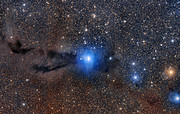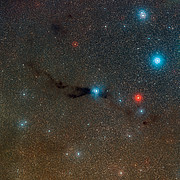Persbericht
Glansrijke duisternis
31 januari 2018
Op deze spectaculaire groothoekopname is een kronkelige donkere wolk van kosmisch stof te zien, die wordt aangelicht door het felle schijnsel van nieuwe sterren. Deze dichte wolk is een stervormingsgebied dat Lupus 3 wordt genoemd. Hier worden uit samentrekkende massa's gas en stof oogverblindend hete sterren geboren. De foto bestaat uit opnamen die zijn gemaakt met de VLT Survey Telescope en de 2,2-meter MPG/ESO-telescoop en is de meest detailrijke die tot nu toe van dit gebied is gemaakt.
Het stervormingsgebied Lupus 3 ligt in het sterrenbeeld Schorpioen, op slechts 600 lichtjaar van de aarde. Het maakt deel uit van een groter complex, de zogeheten Lupus Wolken, dat zijn naam ontleent aan het naburige sterrenbeeld Lupus (Wolf). De wolken lijken op opzwellende rookpluimen die donker afsteken tegen een achtergrond van miljoenen sterren, maar in werkelijkheid gaat het om een donkere nevel.
Nevels zijn grote complexen van gas en stof die zich tussen de sterren uitstrekken, soms over honderden lichtjaren. Waar veel nevels spectaculair worden aangelicht door de intense straling van hete sterren, verhullen donkere nevels het licht van de hemellichamen die zij omsluiten. Ze worden ook wel absorptienevels genoemd, omdat ze bestaan uit koude, dichte stofdeeltjes die licht dat door de wolk trekt absorberen en verstrooien.
Beroemde voorbeelden van donkere nevels zijn de Kolenzaknevel en het Grote Rif, die omvangrijk genoeg zijn om met het blote oog zichtbaar te zijn, pikzwart afgetekend tegen de heldere Melkweg.
Lupus 3 is onregelmatig van vorm: hij lijkt op een misvormde kosmische slang. Op deze foto is het een gebied van contrasten, met dikke donkere banen die afsteken tegen de gloed van de helderblauwe sterren in het midden. Net als de meeste donkere nevels, is Lupus 3 een actief stervormingsgebied, voornamelijk bestaande uit protosterren en zeer jonge sterren. Verstoringen in de omgeving kunnen ertoe leiden dat de dichtere delen van de nevel onder invloed van hun eigen zwaartekracht samentrekken, waardoor de temperatuur en de druk in hun inwendige oploopt. Uiteindelijk leiden de extreme omstandigheden in het hart van zo’n ‘instortende’ wolk tot de geboorte van een protoster.
De twee heldere sterren in het midden van deze foto hebben precies dit proces doorlopen. Eerder in hun bestaan werd de straling die ze uitzonden grotendeels tegengehouden door de dikke sluier van hun moedernevel en waren ze alleen waarneembaar op infrarode en radiogolflengten. Maar naarmate ze warmer en feller werden, veegden ze met hun intense straling en sterke sterrenwinden het gas en stof uit hun omgeving weg, waardoor ze glorieus tevoorschijn konden komen uit hun sombere kraamkamer om licht in de duisternis te scheppen.
Het onderzoek van nevels als deze is van cruciaal belang voor het begrijpen van het stervormingsproces. Aangenomen wordt dat onze zon meer dan vier miljard jaar geleden is geboren in een stervormingsgebied dat veel weg had van Lupus 3. Als een van de dichtstbijzijnde stellaire kraamkamers is Lupus 3 al heel vaak het onderwerp van onderzoek geweest. In 2013 legde de 2,2-meter MPG/ESO-telescoop van de ESO-sterrenwacht op La Silla in Chili een kleiner beeld van zijn donkere rookachtige kolommen en heldere sterren vast (eso1303).
Meer informatie
ESO is de belangrijkste intergouvernementele astronomische organisatie in Europa en verreweg de meest productieve sterrenwacht ter wereld. Zij wordt ondersteund door zestien lidstaten: België, Brazilië, Denemarken, Duitsland, Finland, Frankrijk, Italië, Nederland, Oostenrijk, Polen, Portugal, Spanje, Tsjechië, het Verenigd Koninkrijk, Zweden en Zwitserland, en door gastland Chili. ESO voert een ambitieus programma uit, gericht op het ontwerpen, bouwen en beheren van grote sterrenwachten die astronomen in staat stellen om belangrijke wetenschappelijke ontdekkingen te doen. Ook speelt ESO een leidende rol bij het bevorderen en organiseren van samenwerking op astronomisch gebied. ESO beheert drie waarnemingslocaties van wereldklasse in Chili: La Silla, Paranal en Chajnantor. Op Paranal staan ESO’s Very Large Telescope (VLT), de meest geavanceerde optische sterrenwacht ter wereld, en twee surveytelescopen. VISTA werkt in het infrarood en is de grootste surveytelescoop ter wereld en de VLT Survey Telescope is de grootste telescoop die specifiek is ontworpen om de hemel in zichtbaar licht in kaart te brengen. ESO speelt ook een belangrijke partnerrol bij ALMA, het grootste astronomische project van dit moment. En op Cerro Armazones, nabij Paranal, bouwt ESO de 39-meter Extremely Large Telescope, de ELT, die ‘het grootste oog op de hemel’ ter wereld zal worden.
Links
Contact
Richard Hook
ESO Public Information Officer
Garching bei München, Germany
Tel: +49 89 3200 6655
Mob: +49 151 1537 3591
E-mail: rhook@eso.org
Rodrigo Alvarez (press contact België)
ESO Science Outreach Network
en Planetarium, Royal Observatory of Belgium
Tel: +32-2-474 70 50
E-mail: eson-belgië@eso.org
Over dit bericht
| Persberichten nr.: | eso1804nl-be |
| Naam: | Lupus 3 |
| Type: | Solar System : Nebula : Appearance : Dark Milky Way : Nebula : Type : Star Formation |
| Facility: | MPG/ESO 2.2-metre telescope |
| Instruments: | WFI |
Our use of Cookies
We use cookies that are essential for accessing our websites and using our services. We also use cookies to analyse, measure and improve our websites’ performance, to enable content sharing via social media and to display media content hosted on third-party platforms.
ESO Cookies Policy
The European Organisation for Astronomical Research in the Southern Hemisphere (ESO) is the pre-eminent intergovernmental science and technology organisation in astronomy. It carries out an ambitious programme focused on the design, construction and operation of powerful ground-based observing facilities for astronomy.
This Cookies Policy is intended to provide clarity by outlining the cookies used on the ESO public websites, their functions, the options you have for controlling them, and the ways you can contact us for additional details.
What are cookies?
Cookies are small pieces of data stored on your device by websites you visit. They serve various purposes, such as remembering login credentials and preferences and enhance your browsing experience.
Categories of cookies we use
Essential cookies (always active): These cookies are strictly necessary for the proper functioning of our website. Without these cookies, the website cannot operate correctly, and certain services, such as logging in or accessing secure areas, may not be available; because they are essential for the website’s operation, they cannot be disabled.
Functional Cookies: These cookies enhance your browsing experience by enabling additional features and personalization, such as remembering your preferences and settings. While not strictly necessary for the website to function, they improve usability and convenience; these cookies are only placed if you provide your consent.
Analytics cookies: These cookies collect information about how visitors interact with our website, such as which pages are visited most often and how users navigate the site. This data helps us improve website performance, optimize content, and enhance the user experience; these cookies are only placed if you provide your consent. We use the following analytics cookies.
Matomo Cookies:
This website uses Matomo (formerly Piwik), an open source software which enables the statistical analysis of website visits. Matomo uses cookies (text files) which are saved on your computer and which allow us to analyze how you use our website. The website user information generated by the cookies will only be saved on the servers of our IT Department. We use this information to analyze www.eso.org visits and to prepare reports on website activities. These data will not be disclosed to third parties.
On behalf of ESO, Matomo will use this information for the purpose of evaluating your use of the website, compiling reports on website activity and providing other services relating to website activity and internet usage.
Matomo cookies settings:
Additional Third-party cookies on ESO websites: some of our pages display content from external providers, e.g. YouTube.
Such third-party services are outside of ESO control and may, at any time, change their terms of service, use of cookies, etc.
YouTube: Some videos on the ESO website are embedded from ESO’s official YouTube channel. We have enabled YouTube’s privacy-enhanced mode, meaning that no cookies are set unless the user actively clicks on the video to play it. Additionally, in this mode, YouTube does not store any personally identifiable cookie data for embedded video playbacks. For more details, please refer to YouTube’s embedding videos information page.
Cookies can also be classified based on the following elements.
Regarding the domain, there are:
- First-party cookies, set by the website you are currently visiting. They are stored by the same domain that you are browsing and are used to enhance your experience on that site;
- Third-party cookies, set by a domain other than the one you are currently visiting.
As for their duration, cookies can be:
- Browser-session cookies, which are deleted when the user closes the browser;
- Stored cookies, which stay on the user's device for a predetermined period of time.
How to manage cookies
Cookie settings: You can modify your cookie choices for the ESO webpages at any time by clicking on the link Cookie settings at the bottom of any page.
In your browser: If you wish to delete cookies or instruct your browser to delete or block cookies by default, please visit the help pages of your browser:
Please be aware that if you delete or decline cookies, certain functionalities of our website may be not be available and your browsing experience may be affected.
You can set most browsers to prevent any cookies being placed on your device, but you may then have to manually adjust some preferences every time you visit a site/page. And some services and functionalities may not work properly at all (e.g. profile logging-in, shop check out).
Updates to the ESO Cookies Policy
The ESO Cookies Policy may be subject to future updates, which will be made available on this page.
Additional information
For any queries related to cookies, please contact: pdprATesoDOTorg.
As ESO public webpages are managed by our Department of Communication, your questions will be dealt with the support of the said Department.






